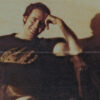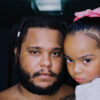At this point, I can’t tell if this is a comedy or a horror,” Sherriff Cole Mack (Frederick Weller) says some time midway through “Only the Good Survive,” and he’s not the only one. For as bright and vivid as Dutch Southern’s neon noir is, it blurs the line between any discernible genres to become something entirely its own as it joins Brea Dunlee (“Never Rarely Sometimes Always” star Sidney Flanagan) in an interrogation room with the unusually pop culture savvy cop who namechecks Paula Abdul and other ‘90s ephemera that fly right over her head, though one suspects any attempt at endearing himself to eke out information would be as successful as drawing blood from a stone. Still, he manages to suss out a plot on the part of Brea and her boyfriend Ry (D’Pharoah Woon-A-Tai) and their literal partners in crime Dev (Darius Fraser) and Erve (Will Ropp) to rob an elderly couple of their ultra-rare gold coin collection, only to find even more precious cargo on the property than they know what to do with.
You probably don’t need or want to know more than that about Dutch Southern’s killer feature directorial debut, which retains the tangy repartee he penned that first turned heads with the 2013 western “Bad Turn Worse,” putting Mackenzie Davis on the map, and introduces him as an equally distinctive visual stylist, throwing splashes of animation into the mix amidst an array of psychedelic action scenes that could easily be confused in terms of their energy. To say that things get crazy wouldn’t do justice to what Southern and crew pull off, though then again “Only the Good Survive” is set in a small Texas town where residents often take the law into their own hands and while Cole has the badge, Brea increasingly looks like she has the authority as she recounts the robbery gone horribly awry. With the delightfully deviant thriller making its bow this weekend at SXSW, Southern shared how he finally found his way into the director’s chair, turning a ranch into a playground for his dark imagination and creating unforgettable characters.
How did this come about?
Well, COVID happened and I had been working on the third pilot that I was writing at the Third Network and realized it wasn’t gonna get greenlit no matter how good it was and like a lot of people, I feel like COVID accelerated the inevitable [which] for me was deciding to direct and from that moment on, the quarantine happened and I started putting a script together. Then I was putting a film together and the next thing I knew I was in the middle of Texas with some amazing actors making a really weirdo movie.
I know a lot of writers go into directing to protect their words and it seems like you would be pretty intent on getting the right cadences to the conversations happening on screen. Was that an exciting part of this?
Yeah, I’m a writer first, so there is a cadence to dialogue and a certain way that you write that if you do it well enough, and you get the right person, you don’t have to tell them, they just do it. Someone like Fred [Weller], who’s got a theater background, I was just in awe watching it come to life because it was literally how I envisioned it and that’s just how he is, he’s that good. But everybody was on that same level, just constantly bringing things. If it wasn’t how I saw it, it was better. Like Darius [Fraser], who plays Dev looked exactly how I pictured the character, but he made a lot of choices that I had not thought of and would not because I don’t have that talent, so I was constantly blown away. There’s still little moments that I see in the film that are what I enjoy the most with Sidney or Will [Ropp] or Darius or D’Pharaoh [Woon-A-Tai] just riffing or coming up with this little thing or a little look that they do that I had never thought of before and if anything, the stuff that bores me the most is what I wrote and then saw executed.
The level of detail in this is extraordinary, and I had to ask since I know you used to screen print T-shirts yourself, is all that character-building that can be done with wardrobe and production design an exciting part of this?
Before I go into my own [experience] of bootlegging shirts, Sidney screen prints too and she’s a great screen printer – I’ve seen her do it and she does her own shirts for her band. She’s amazing. Better than I could ever be, but I had to actually hire people out. And I started out with doing t-shirts – bootlegging, that’s how my script got out and it got on the Black List. And I do sketch every character, their costumes, what they look like and I have a costume designer I love to work with, Michelle Bush, who always brings it to life. What I always say that my ceiling is everyone else’s floor because they’re actual artists and I’m not, but I’ll do my best to sketch some stuff and I hand it off to Michelle, and she builds it from there. If you’ve seen the film, the clothes are all very distinctive and by the end of the film, it’s important how subtly some of the clothing is changing when you start to see the truth of what’s really happening, so all of that’s very important to me.
Was the idea of this really bright, vibrant color palette there for what is essentially a film noir?
Yes, that was very specific. We did all of that film school geeky stuff where we have yellow for fear and the green means something bad is going to happen, so we color coded for all of that and we wanted it to have a very shallow technicolor feel to it and to play with the artifice, like what’s real what’s not real, so once you’re in the interrogation room, obviously it’s more like a man cave [with] greens and browns and much more boring lighting.
Given all the crazy events that are recounted, I couldn’t help but wonder whether the interrogation scene was filmed early in the production or towards the end so there might’ve been a memory of it?
At the very end. The way you’re supposed to do that is you would shoot that first because it’s the easiest stuff, especially on low budget and you’re all in one location – Justin Duprie, one of the producers on this, has a cotton farm in Taft, Texas that I’d visited when I wrote “Bad Turn Worse,” which took place there and this took place in the same town, so that area was exactly how I pictured it when I wrote it – and I made us all shoot [the interrogation] at the very end of the film because I knew that it would be our final rewrite. We shot all the crazy stuff and then anything that we weren’t able to get for whatever reasons, time-wise or money-wise, I would be able to do a rewrite and add some bridges through the interrogation room, so we did all the whacked out weirdo stuff before that and we had three days at the end where we did all the interrogation.
Were there any particularly crazy days of filming in this? Something you might’ve been relieved to pull off?
Like it was so bad that I was glad I was on the other side? I don’t know if there was anything [like] that. I had my favorite days, and it was usually when I would get to be one-on-one with the actor. I loved everybody, but this is an ensemble and when there’s not a lot of time or money, and there’s a lot of people there, it’s much better when you can do one-on-one and I looked forward to the interrogation room because we had so many company moves [before it] and staying in one place was a little more relaxing, if that’s the right word. I mean, it was still a mess. It’s a low budget movie. Every day is hectic.
Since it’s a Texas tale, are you excited about getting to the finish line with it and getting it to South by Southwest?
I can’t think of a better festival for this to play at. I’m not going to start naming festivals, but I don’t know where we would have gone if we didn’t go to South by, to be honest with you and in a way, I guess this was made for South by Southwest. Even if we didn’t know it, I don’t know where else it would play.
“Only the Good Survive” will screen at SXSW on March 10th at 6 pm at the Violet Crown Cinema 2 and 6:30 pm at the Violet Crown Cinema 4, March 12th at 9:15 pm at the Alamo Lamar C, and March 14th at 12:30 pm at the Alamo Lamar E.




